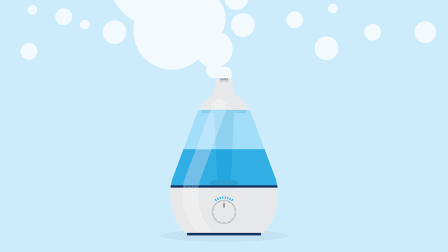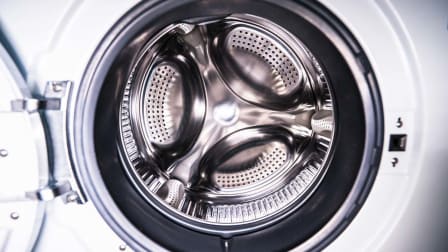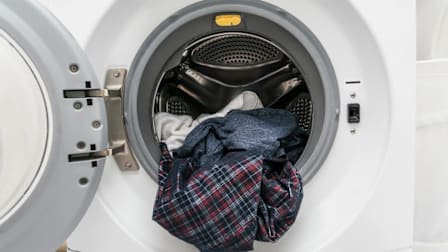How to Prevent Mold From Growing in Your Bathroom
A damp environment can be a breeding ground, so use these tips to keep mold away or get rid of it
When you shop through retailer links on our site, we may earn affiliate commissions. 100% of the fees we collect are used to support our nonprofit mission. Learn more.

It creeps up on you, mold. When you’re not paying attention, black or green spots might appear on your bathroom walls and ceiling. Mold can sneakily stake its claim on your shower curtains. It can also make a conquest of your bathroom mat, spreading throughout the fabric in a way that ultimately makes it unsalvageable, as was the case of my own bathroom mat (R.I.P.).
Not only is mold unattractive and, let’s just say it aloud, really gross, but it can also cause adverse health effects. Some people might suffer symptoms such as a stuffy nose, a sore throat, coughing or wheezing, burning eyes, or skin rash when they’re exposed to mold.
People with asthma or allergies to mold could have more severe reactions. And if you’re immunocompromised or you have chronic lung disease, you might get lung infections, according to the Centers for Disease Control and Prevention.
Mold grows wherever there is moisture, so the bathroom is one of the common places where it might occur. So what are the best ways to prevent it? And if you do see it in your bathroom, how should you remove it? This is what experts suggest.
How to Prevent Mold From Appearing in the First Place
The best way to prevent mold is to reduce any water or moisture sources in your bathroom. Here are a couple things you can do.
1. Ventilate your bathroom. Ventilation is crucial to reducing the humidity level of your bathroom. Run your bathroom exhaust fan during and for at least 30 minutes after a shower, says Mallory Micetich, home expert at home services website Angi. “If possible, you can also keep a window and door cracked during your shower or right after to prevent moisture build-up.”
If you need some extra help to keep the humidity low, try running a dehumidifier. To inhibit mold growth, it’s best to keep the humidity levels in your home at no higher than 50 percent, according to the Centers for Disease Control and Prevention (CDC).
A small capacity dehumidifier will likely be enough for your bathroom, says Misha Kollontai, who oversees dehumidifier testing at Consumer Reports. And if the dehumidifier is going to be a permanent fixture in your bathroom, consider buying one that comes with a pump so you can tuck the drain line along the wall and into the bathtub. That way you don’t have to worry about constantly having to empty the tank.
How to Get Rid of Mold in Your Bathroom
First of all, if the moldy area in your bathroom is bigger than 10 square feet, you should hire a contractor or professional service to tackle the problem, according to the Environmental Protection Agency (EPA).
But if it’s a smaller area of mold, you can try cleaning it up yourself. Before you do so, though, the EPA recommends you limit your exposure to the mold by wearing an N95 respirator, long gloves that extend to the middle of your forearms, and goggles. Also keep the bathroom well-ventilated while you’re cleaning.
Use a stiff-bristled brush to scrub surfaces with dish soap and water or with distilled white vinegar. After scrubbing, let the area sit for 10-15 minutes and then scrub the area again, repeating as needed, Micetich says.
You can also scrub the mold off with a diluted bleach solution. The CDC advises that the solution be no more than 1 cup of household laundry bleach in 1 gallon of water. And when you’re using bleach to clean mold, you should never mix it with ammonia or other household cleaners because that’ll produce a poisonous gas.
You might have to throw away absorbent or porous materials, such as ceiling tiles and any carpet-related materials, if they become moldy. Because the mold can grow in the empty spaces and crevices inside the porous materials, the mold might be difficult or impossible to eliminate completely, according to the EPA.
If your mold keeps coming back after you’re cleaning it, that might mean that moisture is getting behind your building materials, so you’d want to reach out to a professional to repair or remove items that are causing this intrusion, Gershman says.
If you don’t own your home or apartment and your landlord won’t remediate your mold issue, it helps to hire a licensed inspector to complete a mold inspection that will document the severity of your mold growth and any potential health concerns associated with the types of mold spores found in your home, Gershman says.
To escalate the issue, you’d want to report it to your local housing authority and investigate with your state department of public health or environmental protection. Every state, county, and city may have different laws regarding requirements for landlords to handle these issues, so it’s best to investigate locally to see what is required of your landlord and take action from there, Micetich says.
Correction: This article, originally published Feb. 8, 2024, has been updated with the correct last-name spelling for Mallory Micetich, of Angi.




















